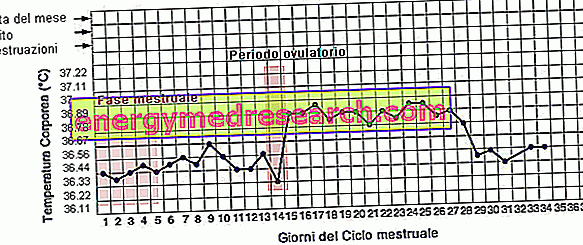What is the thermo-thermal method?
The thermo-thermal method involves combining more natural contraceptive practices:
- Practice Billings
- Basal temperature method
- Analysis of changes in the cervix (through self-examination)
- Evaluation of pre / post-menstrual symptoms (eg breast tenderness, abdominal pain etc.)
Similar to the Ogino-Knaus method, even the thermo-thermal method is considered a method of birth control and natural regulation of fertility. This is because it is up to the couple to decide whether to plan a pregnancy (therefore to consume sexual relations during the potentially fertile days) or to avoid it (refraining from unprotected relationships in the same period).
Married couples are the most suitable category of people to practice the thermo-thermal method as a strategy of first choice to avoid a pregnancy, in full respect of what is dictated by the rules of Religion and the Church. However, it is important to reiterate that the thermo-thermal method - like all the other natural contraceptive strategies - can be used both to prevent pregnancy and to program it. In fact, when a man and a woman desire children, the thermo-thermal method identifies the most fruitful days for the woman, or the period in which she is most predisposed to conception.

Typical course of the menstrual cycle during the various phases of the menstrual cycle
The philosophy of the method
Through the joint evaluation of cervical mucus (Billings method) and body temperature variations during the menstrual cycle, the symptomic method allows us to recognize the potentially fruitful days of the woman. According to this contraceptive philosophy, the couple who do not wish to become pregnant should refrain from unprotected sex 3 days before and 3 days after the peak peak of basal temperature . During this period, the cervical mucus is particularly filamentous and fluid, and the woman perceives a "wet" sensation.
In addition to these factors, the thermo-thermic method involves the careful evaluation of the physiological changes of the uterine cervix (detectable by self-examination of the cervix) and of the symptoms (premenstrual syndrome).
To achieve maximum contraceptive efficacy, the woman following the thermo-thermic method should record DAILY changes in temperature, changes in cervical mucus, changes in the cervix and all other symptoms that occur during the menstrual cycle. For this reason, special recording cards have been designed, the purpose of which is precisely to note down all these aspects to detect (almost) absolute certainty the woman's fertile days.
Interpretation of signals
We see, in the table, some indications that help the woman to interpret the different signs sent by the organism.
| Period | Signal | Interpretation of the signal according to the thermo-thermal method |
| Immediately after menstruation | Low body temperature, but constantly increasing + absence of cervical mucus ("dry" vagina) + absence of breast tenderness | The woman is not fertile |
| After a few days after menstruation | Stabilization of body temperature + appearance of mucus (pasty and NOT fluid) | The woman is not yet fertile (very little chance of conception) |
| After 7-10 days from menstruation | Production of stringy and watery cervical mucus + start of dilation of the cervix | Estrogen increases rapidly, while progesterone increases more slowly → The woman begins to be potentially fertile |
| Ovulation (about 14 days after menstruation) | Drastic drop in basal temperature * followed by an evident and sudden rise of 0.5-0.9 ° C (biphasic thermal curve) + Loss of mucus with a consistency comparable to raw egg white + "soft" uterine cervix with dilated orifice | Rapid decrease in estrogen (after the maximum temperature peak) and increase in progesterone → very high probability of conception |
| Post-ovulation period (3-4 days after the end of ovulation) | Maintaining high values of basal temperature for 12-14 days (until the next menstruation arrives) + Absence of cervical mucus + (possible) abdominal swelling, breast turgor and mood alteration | The woman is no longer fertile |
(*) the basal temperature of the woman is best measured in the morning as soon as she wakes up, using a special thermometer to be inserted into the vagina. The temperature increase that characterizes the period immediately following ovulation does not generally exceed Celsius. The woman's basal temperature tends to present lower levels immediately after menstruation, and then increases by 0.5-0.9 ° C in the hours following ovulation. Then, in the subsequent phase of the cycle, known as luteal, the temperature remains at high levels, even though it undergoes a slight and almost constant reduction.
Through the careful combined interpretation of all these signs and symptoms, the woman can understand on which days she is most at risk of pregnancy.
Syntothermal method and reliability
Some authors venture to say that the reliability of the thermo-thermal method is almost comparable to those of the latest generation of hormonal contraceptives, such as estrogen-progestin pill, contraceptive ring / patch and IUD spiral. In reality, however, the contraceptive efficacy of the thermo-thermal method has to deal with the influence of many factors (stress, environmental factors, state of nutrition, etc.), which could mislead the woman, generating temperature fluctuations very similar to those of the ovulatory period. Suffice it to say that the Pearl index assigned to the thermo-thermal method ranges from a very low value (0.6) to 2.6.
To understand...
The Pearl Index is a standard method to evaluate the effectiveness of all contraceptive methods. The Pearl index is indirectly proportional to the contraceptive efficacy (the greater the value, the lower its effectiveness). For a practical comparison, let us remember that the Pearl index of contraceptive pills is around 0.1.
The thermo-thermic method requires a great mastery of one's body and an extreme commitment on the part of the woman. For this reason, in a contraceptive key, the thermo-thermic method is today scarcely used by young couples who want to minimize the risk of unwanted pregnancies; instead, it finds space in stable relationships between adult and consenting people, ready to accept a possible failure of the contraceptive protection guaranteed by the thermo-thermal method.



